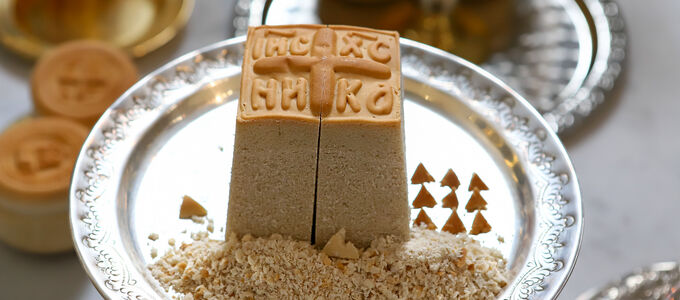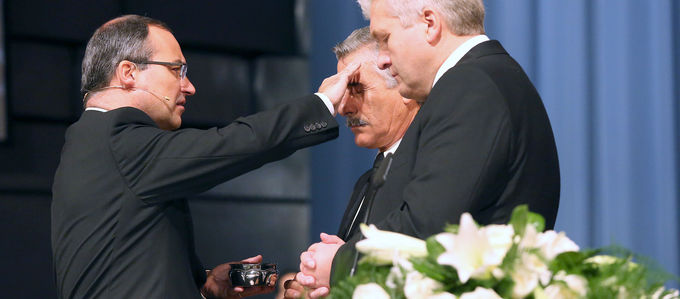
What is the real focus of the congregation when celebrating Holy Communion? Fellowship with Christ, or fellowship with one another? The answer is reflected in the manner in which the believers gather for the sacrament and receive the elements.
Holy Communion is consecrated—and then? In practice, there are basically three methods by which participants can access the Communion elements in the churches today:
- believers come forward for the Lord’s Supper: the participants leave their seats, move to the altar area, and there receive bread and wine. This is the practice in the New Apostolic Church, for example.
- the believers come together: participants stand up and form a circle or semicircle, or sit down together at a table. The former practice is familiar in some Protestant churches and the Catholic Church, for example, while the latter is customary for Baptists, among others.
- the Lord’s Supper comes to the believers: the participants remain at their seats and the elements are brought to them. This is the way things are handled in the Reformed Churches, for example.
Between theology and practice
In the first case, it is usually the clergy—who have been ordained or appointed for this purpose—who dispense Holy Communion. This rite is generally intended to emphasise that Jesus Christ is the One who has instituted the sacred celebration and who invites the believers to come to Him.
In the second and third cases, the members of the congregation frequently pass the elements of Communion to one another. This is not only to emphasises the idea of community, but rather also the notion of the universal priesthood of believers.
The particular form a congregation practises differs not only from denomination to denomination, but also within denominations. After all, this too is a very practical matter: the more participants there are, the more difficult it is to gather in a circle or semicircle, or to sit down at a table.
By whose hand do the elements enter the believer’s mouth?
There are also differences in the manner in which the believers receive the Communion elements. This already begins with the bread. Up until the ninth century it was customary for believers to receive the elements in their hands.
However, already as early as the sixth century, another practice developed in which the believers would kneel down and receive the Communion elements directly on the tongue. In 878, the Council of Rouen made this variant a binding requirement—which to this day still applies, in principle—in the Catholic Church. In the meantime, however, participants have been given the right to choose how they wish to receive the sacrament.
And there are even reasons behind each of these two ways of receiving the sacrament. Those who advocate Communion on the tongue are concerned with showing the proper respect for the Lord’s Supper. By contrast, proponents of Communion on the hand emphasise the character of the sacrament as a meal, in which believers place the elements into their own mouths.
With a straw or a spoon?
There are even more variants for dispensing the wine: the communal chalice is usually regarded as the original form for partaking in the wine. In this case, all the participants drink from the same cup, which can be wiped off and turned a little between participants as necessary.
On the other hand, there are also hygienic concerns—and these are not new. Individual cups as possible solutions stand in contradiction to the idea of community. The idea of using a kind of straw was also used in the past. The fistula—a suction tube usually made of silver—was still in common use at Papal masses well into the 20th century, but has now practically died out.
By contrast, the practice of intinction, in which the wafer is dipped into the wine and then usually dispensed to believers on the tongue—is still in use to this day. A special variant of this is practised in the Orthodox Churches: wafer and wine are mixed together and dispensed to the recipients on a spoon known as the Cochlear. More than a hundred years ago, the New Apostolic Congregations in the Netherlands tried using ivory forks, before the Church introduced the combined wafer.
Tags














